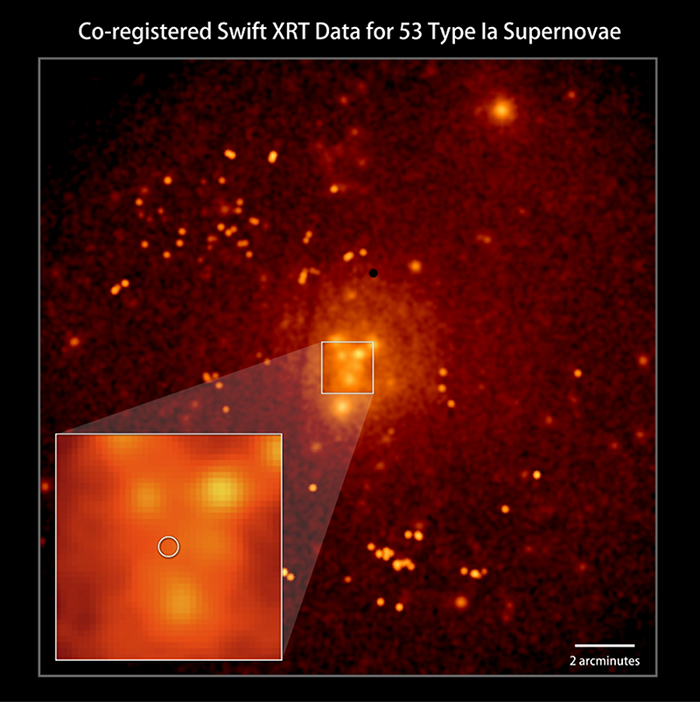
 Credit: NASA/Swift/Stefan Immler
Credit: NASA/Swift/Stefan Immler
Double Degenerate?
One of the most pressing problems for today's astrophysicists: how are standard
candles made? The candles, in this particular case, refer to those consistent
explosions, Type Ia supernovae, that are so useful for probing
the structure of the Universe. Type Ia supernova are characterized by a
similar chemical composition, and the similar behavior of their "light curves",
i.e. how the supernova's light varies near the time of the explosion and for
weeks afterwards. These Type Ia supernova are believed to involve the
destruction of a white dwarf star. White
dwarfs are the remnants of the cores of intermediate-to-low mass stars (like
the Sun), in which about one Sun's worth of mass is packed into an object the
size of the earth. As a result, white dwarfs are incredibly dense - one teaspoon
of a white dwarf's material would contain as much mass as an automobile. White
dwarfs exist because of a struggle between gravity and quantum mechanics. The
crush of the white dwarf's enormous gravity is opposed by a quantum mechanical
force called electron
degeneracy pressure. But there's an ultimate limit to how much mass electron
degeneracy pressure can support. This maximum mass is called the Chandrasekhar
limit, and for typical white dwarfs is about 1.4 times the mass of the Sun.
Type Ia supernovae occur when a white dwarf exceeds the Chandrasekhar limit, at
which time the star can explode. But exactly how this explosion occurs is,
currently, a puzzle. One suggestion is that a single white dwarf can accrete
matter from a nearby normal star, eventually pushing it above the Chandrasekhar
limit. An alternate scenario is that the supernova could be produced by the
merger of two degenerate white dwarfs in orbit around each other. To help
investigate the nature of the Type Ia progenitors, astronomers have merged 53
X-ray observations of Type Ia supernova seen by NASA's Swift observatory, to look for tell-tail
signs of the explosion. If the accretion scenario is correct, and the companion
is a supergiant or red giant star, there should be some excess X-ray and
ultraviolet emission left behind after the supernova explosion; if the merger
scenario is right, there should be little excess X-ray or UV emission at the
position of the supernova. The image above shows the combined Swift X-ray images
of Type Ia supernovae, all centered on each individual supernova. This provides
the equivalent sensitivity of a 35-day observation. The inset shows the region
near the image center around the supernovae. Although there are random bright
sources near the center of the image, there's no detectable X-ray excess at the
position of these supernovae (marked by the white circle). These combined X-ray
data, along with associated ultraviolet observations by Swift, suggest that
either the "double-degenerate" merger model predominates, or that the companions
to the white dwarfs are as small as or smaller than the Sun.
Published: March 26, 2012
<
HEA Dictionary ● Archive
● Search HEAPOW
● Other Languages
● HEAPOW on Facebook
● Download all Images
● Education ● HEAD
>

Each week the HEASARC
brings you new, exciting and beautiful images from X-ray and Gamma ray
astronomy. Check back each week and be sure to check out the HEAPOW archive!
Page Author: Dr. Michael F. Corcoran
Last modified Tuesday, 27-Feb-2024 10:15:22 EST


